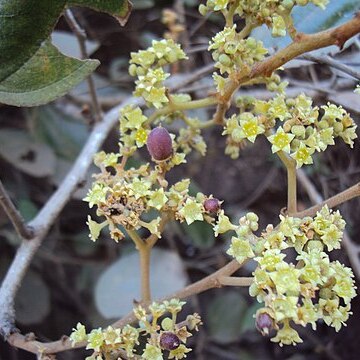Shrubs or small trees, evergreen, to 9 m tall, spinose. Young branches densely ferruginous or yellow-brown tomentose; old branches red-brown, scabrous, striate, with conspicuous lenticels. Stipular spines 1(or 2), recurved, purple-red, 3-6 mm; petiole short, 5-9 mm, stout, densely yellow-brown tomentose; leaf blade broadly ovate or broadly elliptic, 8-11 × 4.5-9.5 cm, papery or subleathery, abaxially densely ferruginous or yellow-brown tomentose, adaxially at first villous, gradually glabrescent or later sparsely pubescent in vein axils, 3-5-veined from base, midvein with 2-5 pairs of secondary veins, veins prominent abaxially, impressed adaxially, base subcordate or rounded, oblique, margin serrulate, apex rounded. Inflorescences to 20 cm. Flowers green, densely pubescent, few to 10 in terminal or axillary large cymose panicles or cymose racemes; peduncles 5-12 mm. Pedicel ca. 2 mm, densely ferruginous tomentose. Sepals triangular, subequal to calyx tube, abaxially ferruginous tomentose, adaxially slightly keeled, apex acute. Petals absent. Disk orbicular, rather thick, 5-lobed, outer rim inconspicuous. Ovary globose, densely tomentose, to ca. 1/3 immersed in disk; styles deeply 2-cleft or 2-cleft to half. Drupe orange, turning black at maturity, obovoid-globose or subglobose, 9-12 mm, 8-10 mm in diam., hairy, gradually glabrescent, with persistent tube at base; fruiting pedicel 7-10 mm, tomentose; endocarp fragile-crustaceous; stone 1-loculed, 1-seeded. Seeds red-brown, globose, 6-7 × 6-7 mm. Fl. Mar-May, fr. Apr-Jun. 2n = 24.
More
A shrub or small tree. It grows to about 5 m high. It can be a straggler and loses it leaves during the year. The bark is dark grey. It is deeply cracked into thick rectangular scales. The leaves have stalks. They are 5.5-13 cm long by 3-11 cm wide. They are almost round or oval with teeth. They are dark green above. They are thick grey or rusty colour and like felt underneath. They are obliquely rounded at the base. The flowers are yellowish. The occur in long panicles at the ends of branches or in the axils or leaves. The fruit is fleshy with a hard covering over the seed. The fruit is round or pear shaped. It is 5-8 mm across and white when ripe.
Riverbanks, Shorea forest; at elevations up to 1,200 metres. Sparse forests and thickets on hills, sunny places on mountains; at elevations up to 1,400 metres.
More
A tropical plant. In Nepal plants grow to 1200 m altitude. It grows on the Deccan in India. In Yunnan.

